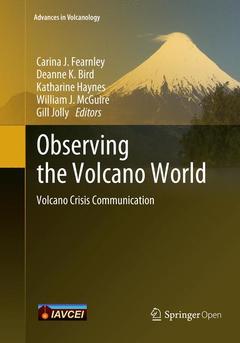Observing the Volcano World, Softcover reprint of the original 1st ed. 2018 Volcano Crisis Communication Advances in Volcanology Series

This open access book provides a comprehensive overview of volcanic crisis research, the goal being to establish ways of successfully applying volcanology in practice and to identify areas that need to be addressed for future progress. It shows how volcano crises are managed in practice, and helps to establish best practices. Consequently the book brings together authors from all over the globe who work with volcanoes, ranging from observatory volcanologists, disaster practitioners and government officials to NGO-based and government practitioners to address three key aspects of volcanic crises.
First, the book explores the unique nature of volcanic hazards, which makes them a particularly challenging threat to forecast and manage, due in part to their varying spatial and temporal characteristics. Second, it presents lessons learned on how to best manage volcanic events based on a number of crises that have shaped our understanding of volcanic hazards and crises management. Third, it discusses the diverse and wide-ranging aspects of communication involved in crises, which merge old practices and new technologies to accommodate an increasingly challenging and globalised world.
The information and insights presented here are essential to tapping established knowledge, moving towards more robust volcanic crises management, and understanding how the volcanic world is perceived from a range of standpoints and contexts around the globe.
Deanne Bird is a geographer, with a focus on community engagement and risk communication. She is currently working as a Research Specialist with the University of Iceland where she is exploring human behaviour before, during and after disaster to identify factors that influence decision-making among at-risk regional and rural populations and the tourism sector. In particular, Deanne is interested in developing and assessing the efficacy of risk communication tools and strategies to drive behaviour change. Deanne is also contracted as a Senior Advisor – Community Engagement for the Victorian Department of Health and Human Services within the Latrobe Health Innovation Zone team. As a Senior Advisor, Deanne is responsible for local project leadership, coordination, monitoring and reporting relating to health specific actions arising from the Hazelwood Mine Fire Inquiry 2016. She also enjoys an adjunct position with Monash University, Melbourne.
Katharine Haynes is a Senior Research Fellow in the Department of Geography and Planning at Macquarie University, Sydney researching the human dimensions of hazards and risk. She is particularly interested in community and child-centred disaster risk reduction and has considerable experience undertaking research with post disa
A unique collection harnessing international expertise and experience to review volcanic crises around the world
Brings together for the first time a wealth of undocumented knowledge to provide a platform for understanding how volcano crises are managed in practice, and to establish effective best practices
Includes a glossary, bibliography, and annotated further reading lists, along with a linked author website
Date de parution : 02-2019
Ouvrage de 771 p.
17.8x25.4 cm
Disponible chez l'éditeur (délai d'approvisionnement : 15 jours).
Prix indicatif 52,74 €
Ajouter au panierDate de parution : 06-2018
Ouvrage de 771 p.
17.8x25.4 cm



